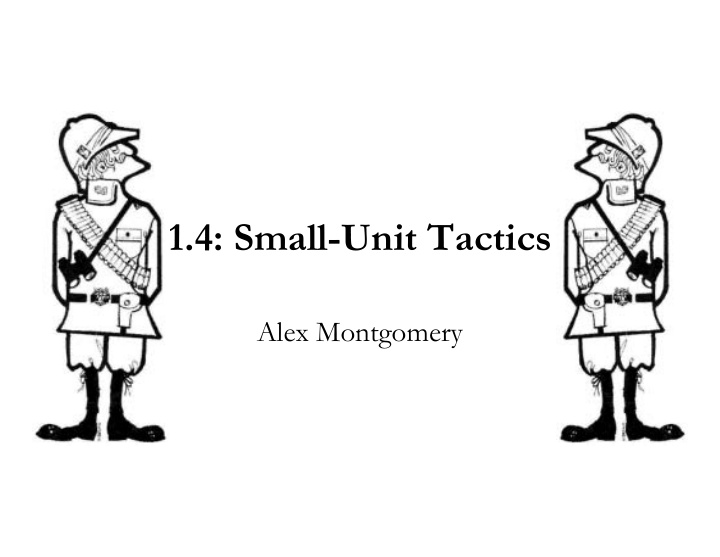



1.4: Small-Unit Tactics Alex Montgomery
Defence of Duffer’s Drift • E.D. Swinton (1868-1951) • Credited for inventing the tank • Fought in the Boer War (1899-1902) – Dutch settlers v. British – Guerrilla warfare – Ended Treaty of Vereeniging, May 1902
Defence of Duffer’s Drift (1) SILLIAASVOGEL RIVER (2) DRIFT (3) REGRET TABLE MOUNTAIN (4) WASCHOUT HILL (5) INCIDENTAMBIA (6) KRAAL
First Dream Assumptions • Picks, shovels unnecessary • Rising ground good • Guard target closely • Natural obstacle • Enemy far away • Information from locals valid • Locals not hostile • Fires a good idea
First Dream Results: Lessons: • Assault before dawn 1. Do not put off defense • Locals aid Boers in 2. Do not trust locals intelligence 3. Do not advertise position • Brits: 10 killed, 21 wounded 4. Do not be in tents • Boers: 1 killed, 2 wounded • Boer convoy crosses drift
Second Dream Assumptions: • Keeping posts further out gives more time • Square Trenches sufficient • Soldiers only diggers • Keep locals out, fires out sufficient
Second Dream Results: Lessons: • Brits: 24 killed, 6 wounded 5. With modern weapons: a) Don’t sit on top of drift • Boers able to fire from cover of bushes b) Make positions away from concealed ground • Brit position known c) Make defences concealed • Brits unable to fire from and bullet-proof cover d) Square trenches not • Square trenches increase effective casulties 6. Spread disinformation 7. Force labor
Third Dream Assumptions: • Position outside horseshoe better cover • Straight trench w/single break sufficient • Sufficient to guard male population • Enemy has same arms as you
Third Dream Results: Lessons: • Shelled from a distance 8. Gather all possible locals • Trenches useless (a target) 9. Against shelling, scatter against indirect fire troops; against direct fire, gather. • Location given away by other locals 10. Narrow, steep, trapezoidal trenches necessary
Fourth Dream Assumptions: • Dead animals won’t be noticed • Solid parapet sufficient for return fire • Obvious front: North • No cover for trench necessary
Fourth Dream Lessons: Results: 11. The front is everywhere • Position detected 12. Watch your rear • Trench enfiladed 13. Beware of being enfiladed • Position surrounded a) Rifle fire b) Long-range guns • Brits incapable of returning 14. Do not put your trench behind effective fire rising ground 15. Do not huddle your men • Brits: 25 killed, 17 wounded 16. Cover from sight worth more than from bullets 17. Surprise a great advantage 18. Conceal your position 19. Look from the enemy’s view
Trench Design • Trenches built in zig-zag to avoid enfilading • Support/Communications/ Reserve trenches connected • Allow for reinforcement under cover • Cover under parapet against shelling • Back and front covered against shelling/fire • Cut-outs for firing
Fifth Dream Assumptions: • High ground is sufficient • Guarding ground is a solely defensive operation • Cover is the main criterion when choosing positions
Fifth Dream Results: Lessons: • Deception useful 20. Beware dead ground – Boer scouts caught off-guard 21. Hill not the best (only) – Sandbags provided false place to hold target 22. Bluffs are good • Ground made up for numbers • “Dead ground” made road safe for Boers to pass under covering fire
Force Deployment • Good ground: – Highest points – Close to objectives – Be aware of dead ground – Can direct fire to multiple areas • Internal lines: – Capable of quick reinforcement – Troops don’t waste energy
Sixth Dream Strategy: • Trenches to cover dead ground • Decentralized command • Use of natural cover • Extensive deception Results: • Brits: 11 killed, 15 wounded • Boers: 25+ killed • Drift held
Commentary…
Recommend
More recommend